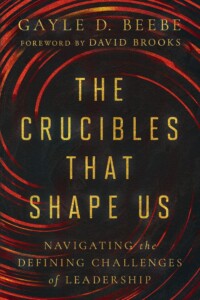
The Crucibles That Shape Us: Navigating the Defining Challenges of Leadership
The Crucibles that Shape Us by Gayle Beebe is an important addition to the Christian leadership literature on the challenges and growth that leaders will experience over the course of their careers. The book fills a missing space between books for secular business leaders and Christian ministry leaders. This book is written for Christian leaders in any organization who are seeking to integrate what they hear in a Sunday morning sermon with the leadership challenges they face on Monday morning.
The book parallels leadership research showing that over 70% of a leader’s development will occur on the job, in trial-by-fire experiences, teaching lessons that could never be learned in a classroom.1 In Beebe’s words, “I have come to see my hardships not as barriers to God, but as divine passageways. Ultimately, I have discovered that my crucibles are the same trials God has used throughout history to challenge and shape his people—but only when they let him. How, then, do we let him?” (7). This represents one of the strengths of the book: it is written by a leader who has personally faced these challenges, not an academic passing on advice that he or she hasn’t lived.
The book explores seven crucibles that a leader is likely to face: (1) missed meaning—the failure to perceive reality accurately to see the bigger whole; (2) enduring challenge—the temptation to give up rather than persist and pursue a larger mission; (3) human treachery—betrayal from people one trusts and the opportunity for building greater self-awareness and self-correction; (4) awakened moral conscience—when one fails to live up to one’s own convictions and the potential to build one’s character and integrity; (5) social conflict—creating environments not of conflict but of belonging where individuals are celebrated for the diversity that is the kingdom of God; (6) human suffering—facing evil and anguish and drawing on God and a faithful community to endure; and (7) personal choice—making choices that go wrong and preparing for future decision points.
Each chapter describes the crucible that leaders can face followed by guidance on how leaders can navigate these moments drawing on scripture, historical voices, and Beebe’s personal insights. Beebe suggests three overarching questions that should frame how leaders approach the crucibles in their lives: Do I accurately see and understand what is happening to me? What is happening inside me? And what is happening because of me? To facilitate this, each chapter contains reflection questions, and group discussion questions are provided at the back of the book to explore specific themes more deeply.
In discussing the challenges, Beebe speaks as the president of a Christian liberal arts college, impressively drawing on a wide range of disciplines including theology, philosophy, biology, business, the humanities, sociology, and psychology, among others. From the writings of Saint Augustine to Daniel Kahneman’s Thinking, Fast and Slow, the chapters weave together historic thought with recent science.2
The book is written from the perspective of God’s assurance that there is grace on the other side where answers are available. God is in control and things will work for the glory of God in the end if one is faithful. While business leadership today is often framed as how to be successful and win, Beebe frames his crucibles in the Christian redemption narrative. But the positive narrative that he presents needs to be supplemented with other writers who present about how it feels “in the valley of the shadow of death” (Psalm 23:4). When a leader is in the middle of the story, it’s never clear if it will turn out as a tragedy, comedy, or theatre of the absurd.3 Sometimes things don’t work out as planned, even when a leader does everything correctly. In the middle of a crucible, leaders need permission to feel the dark night of the soul, and there are people Beebe cites who have written vulnerably about those times in their lives. Thus, it would be good to pair The Crucibles That Shape Us with the autobiographies of leaders referenced in the book such as Frederick Douglass, Winston Churchill, Martin Luther King Jr., Rosa Parks, or Simone Weil, to understand what they held onto when everything felt like it was falling apart. What allowed Winston Churchill to persevere through the 1930s when he was politically sidelined during the rise of Nazi Germany? How did Martin Luther King Jr.’s and Rosa Park’s faith help them lead the Montgomery Bus Boycott for a year amid threats and violence?
Leadership research suggests that there are four elements critical to leader development and effectiveness: talent/gifts, experiences, lessons, and agility to capture the learning.4 The Crucibles That Shape Us draws on all four but offers a Christian perspective that is largely missing in scholarship today. Where today’s organizations are looking for leaders that are “high potentials” in a survival-of-the-fittest contest, Beebe notes that Christianity encourages leaders to draw on their God-given talents to find their calling to serve in the roles in which they have been placed. Where our culture tells a person to seek success and achievement, he notes that God refines us in moments of crisis—we are called to be faithful and listen for God’s voice. Where the culture looks for tactical and strategic lessons to win, he considers how we are called to grow in our character and serve others. Where business is looking for practices and tactics to get ahead, he challenges readers to draw on God, scripture, and the people God has placed in their lives. Leadership isn’t a prize to be sought but a calling to be lived.
I hope that future work can be done to continue to build resources for Christian business leaders. Three areas are particularly important: the leadership metaphor that Christian leaders adopt in their work, specific practices to integrate one’s faith to navigate the Christian leadership journey, and how to deal with failure. To begin, Beebe and other Christian writing focuses heavily on his first two reflection questions: Do I accurately see what’s happening to me? What’s happening inside me? Future work needs to be done to expand on Beebe’s third question: What is happening because of me? In a complex system with multiple stakeholders, a leader will never please everyone.5 Tough choices will always have to be made. Given this, what is the framing that a Christian leader should adopt and how does it differ from a secular leader?
Several potential leadership metaphors are present in scripture. When I have taught ministerial leadership, three of the more common ones that students draw on are leader as shepherd, servant, and steward. All three have strengths as well as weaknesses when taken to the extreme. For example, on the one hand, shepherd leaders are selfless, caring about every individual and especially the lost sheep. On the other hand, shepherds can be so concerned with the exceptions that they fail to build organizations where the other 99 percent can thrive. In contrast, people who see themselves as servant leaders know that their role is not to dominate but serve others. They are called to follow Christ who washed the disciples’ feet as a servant; however, adopting a servant or subordinate stance can be problematic for minorities or women in environments where they are devalued or discriminated against. Servant leaders need to balance this with images of the body of Christ where no one is better or worse than others but need to live in such a way that their unique role, lived experiences, and talents make them a member of a body where everyone is equally valued. Finally, leaders who adopt a stewardship model understand their roles as overseeing the responsibilities God has entrusted to them, but in the extreme, this can become a quest to build barns and riches that do not last. More work is needed in the future to help managers figure out how to frame their leadership roles and their impact on other people in healthy ways.
Secondly, Christian leaders could use more guidance on how they can draw on their faith to ensure they are capturing the lessons of experience. Secular research calls this learning “agility,”6 but the role that God and spiritual faith can play is seldom mentioned. Beebe refers to several potential sources, including among others prayer, scripture, and spiritual communities. Further work is needed to identify specific spiritual leadership practices that can be adopted within the workplace.7
Finally, more resources are needed for Christian leaders on how to deal with failure. Beebe’s book moves this discussion forward by normalizing leader crucibles. But the crucibles in American Christian communities are often talked about only in the context of something that is going to get better. Leaders need more resources that move beyond simplistic clichés (e.g., “failing forward” or “all things work together for good”). Sometimes organizations and leaders fail even when they do everything right. We are broken pots.8 In the end, Christians are called to be faithful, not successful. As an example, in a letter to a discouraged young activist, Thomas Merton wrote:
Do not depend on the hope of results. When you are doing the sort of work you have taken on, essentially an apostolic work, you may have to face the fact that your work will be apparently worthless and even achieve no result at all, if not perhaps results opposite to what you expect. As you get used to this idea you start more and more to concentrate not on the results but on the value, the rightness, the truth of the work itself. And there too a great deal has to be gone through, as gradually you struggle less and less for an idea and more and more for specific people. The range tends to narrow down, but it gets much more real. In the end, as you yourself mention in passing, it is the reality of personal relationships that saves everything.”9
Future work is needed to help Christian leaders when they feel like they are in the Garden of Gethsemane.
In conclusion, the world needs more guidance for Christian leaders like The Crucibles that Shape Us. Christians offer a different way of seeing the world, where every person is valuable, a child of God. The journey will be difficult. But God calls broken people to serve a broken world. A new generation of Christian leaders is waiting to live into that hope.
Cite this article
Footnotes
- Morgan W. McCall Jr., High Flyers: Developing the Next Generation of Leaders (Harvard Business School Publishing, 1998).
- Daniel Kahneman, Thinking, Fast and Slow (Farrar, Straus and Giroux, 2013).
- Frederick Buechner, Telling the Truth: The Gospel as Tragedy, Comedy, and Fairy Tale (Harper & Row, 1977).
- Paul R. Yost and Mary Mannion Plunkett, Real-Time Leadership Development (Wiley-Blackwell, 2009).
- Ronald A. Heifetz, Leadership Without Easy Answers (Harvard University Press, 1994).
- Kenneth De Meuse and Victoria Harvey, The Age of Agility: Building Agile Leaders and Organizations (Oxford University Press, 2021).
- See, for example, Denise Daniels and Shannon Vanderwarker, Working in the Presence of God: Spiritual Practices for Everyday Work (Hendrickson Publishers, 2019).
- Robert McKenna, Dying to Lead: Sacrificial Leadership in a Self-Centered World (Xulon Press, 2008).
- See Jim Forest, “Thomas Merton’s Letter to a Young Activist,” Jim & Nancy Forest, https://jimandnancyforest.com/2014/10/mertons-letter-to-a-young-activist/. Also published as a chapter in Jim Forest, The Root of War is Fear: Thomas Merton’s Advice to Peacemakers (Orbis, 2016),























